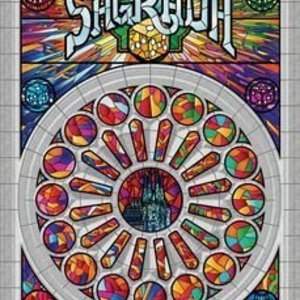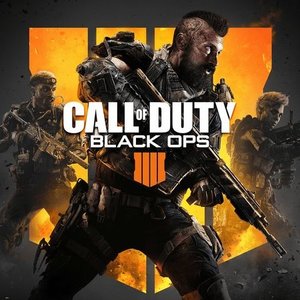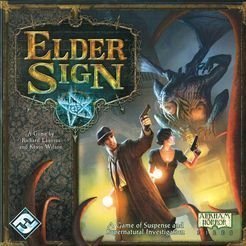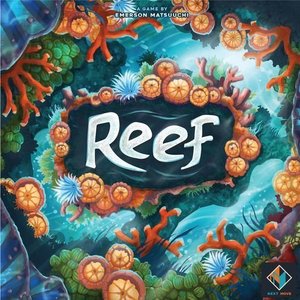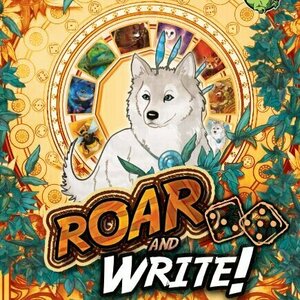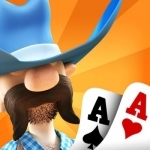
Governor of Poker 2 HD - Texas Holdem Poker without internet
Games and Entertainment
App
PLAY POKER, FREE SINGLE PLAYER HOLDEM POKER OFFLINE on your iOS device and beat every cowboy in...

Stratego® Single Player
Games and Entertainment
App
Play the best Strategy game ever! Stratego® Official Single Player from Jumbo is all about good...
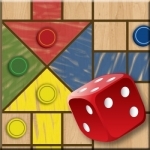
Classic Ludo Offline & Online
Games
App
NEW: Multiplayer Online with Facebook Friends available now. Calling all the kings of Ludo game,...
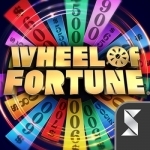
Wheel of Fortune: TV Game Show
Games and Entertainment
App
Have you ever wanted to buy a vowel? Spin the Wheel with Pat Sajak? Guess letters and watch them...
Purple Phoenix Games (2266 KP) rated Sagrada in Tabletop Games
Jun 12, 2019
In Sagrada, you are an artist who has been tasked with creating a beautiful stained glass window. Working piece by piece, you build a masterpiece – the likes of which have never before been witnessed. Finding the perfect pieces can be tricky, but through careful use of your tools and with your artistic vision, you can create the best window in the town! The game is played over 10 rounds in which players draft dice and place them in their windows, following certain placement restrictions. A set number of tools are available for use, and can aid you in manipulating the dice to your benefit. Points are scored based on successful completion of private and public objectives, and the player with the highest score at the end of 10 drafting rounds is the winner!
My favorite part about playing Sagrada solo is that the game is essentially played the same way, regardless of player count. The only difference is how you win! In both group and solo play, each player will draft two dice every round. In group play, any leftover dice are discarded, while in solo play, the remaining two dice will be added towards the Target Score – the score you are trying to beat at the end of the game! To find the Target Score, you add all of the die values of your unused dice from each round. If, at the end of the 10 rounds, you have earned more points than the Target Score, you win! But if the Target Score is higher than your final score, you lose.
The game play differences are simple enough, but actually winning the game solo is a different story. I have played Sagrada solo quite a bit, and have won maybe 25% of the time. Depending on which window card and objectives are in play, and because of placement restrictions, I often have to sacrifice high-valued dice to the Target Score. And since there are no placement restrictions for the Target Score, and two dice are added to it each round, it is very easy for that score to sky-rocket. I either barely pull off a win, or I lose by a huge margin. Playing in a group is nicer in this regard because the other players have the same placement restrictions that I have – nobody is just getting points for free. Without the Target Score, there really is no way to play Sagrada solo, but it makes the game feel a little imbalanced to me.
Just because it is difficult to win solo does not mean that I do not like the game. It requires quite a bit of strategy, and that keeps me engaged for the entire game. There are dice placement restrictions based on color AND value, so there are two different ways in which you have to constantly be strategizing. You can’t just focus on either value or color – your strategy must always be changing based on which color dice are drawn and what values are subsequently rolled. Even with the amount of strategy required, Sagrada actually plays pretty quickly as a solo game, and I really like that. I like the challenge of this game, and often try to play until I can win. Since I can finish an entire solo game in probably 10-15 minutes, I am able to get multiple plays in a row!
Sagrada is a challenging game to play solo, but not in a way that feels futile. I don’t win a lot, but the strategic implications and the pretty dice colors are what keep me coming back to this game! If you haven’t tried Sagrada solo yet, I’d encourage you to give it a shot. But be warned – you might not always win.
https://purplephoenixgames.wordpress.com/2019/02/26/solo-chronicles-sagrada/
Gareth von Kallenbach (980 KP) rated Call of Duty: Black Ops 4 in Video Games
Jun 19, 2019
I played the game first at E3 and then again during the Beta phases for the game so I had a decent familiarity with what to expect when the full release version of the game arrived.
After several days of playing the game, I have to say it is to me a mixed bag and many aspects of it disappointed me which is very frustrating as fan of the series since the very first game.
The look and feel of the game does not come across to me as a new game but instead to me look and play like DLC for Call of Duty: Black Ops 3. Many of the maps seem familiar and have been updated from their appearances in previous games. The same holds true for the weapons and kill streaks. I am not saying it is not fun, but it all has a sense of having seen most of it before.
Another very annoying change to the game is the severe limitation of grenades in the game. Usually a player has a grenade option which comes in handy when Snipers setup behind cover. Without the ability to lob a grenade to get Snipers out from cover, players are easy pickings, especially when the first appear on the screen. You can unload a full clip into a player at a distance and still end up dead with one shot from a sniper. As such you have to wait until you reach level 42 in order to add them to your customized loadout and even then they are very Nerfed from what players have come to expect.
The multiplayer modes are what you have come to expect as there are the Team Deathmatch variations as well as the Capture and Control modes and a new mode called Heist where players need to capture or prevent the capture of a target.
For me the most enjoyable aspect of the game was the Zombie modes as not only were the players I was matched with usually very helpful, but they were also much friendlier than many of the other people I encountered.
The Blackout mode is very popular with gamers but not being a fan of the One and Done mode of play, I found myself enjoying the vast details of the map and preferring to work with a team, capturing vehicles, and such. I have seen multiple players unload point blank on a player in this mode only to see them walk away and one shot kill their attackers. This is either a hack or an example of how imbalanced things can be at times and you will see multiple instances of players taking numerous hits and walking away while others go down with one shot.
Black Ops IIII does not have a regenerative health system and instead requires players to use a timed injection in order to restore health.
This is all designed to foster teamwork and to make the game more appealing to the eSports community. While this is nice, it deviates from much of what has made the game so appealing from the start.
The game to me seems like it was hurried to market as it released on October 12th vs the traditional November release date. I am sure a big part of this was a desire to beat Red Dead Redemption 2 to market but in doing so it seems that things are missing from the final product.
There is much to like about the game as it is still an exciting and intense experience but to me is the first Call of Duty game to not feel shiny and new but instead more of the same in many cases.
The developers have supported the game with numerous updates and there are more on the way as well as planned DLC down the road so the game as it is now is likely to change in the next few months as more feedback is given to developers and new features are added.
Hopefully they will also look to add a campaign at a later date as although it is fun, it seems lacking and dated in many aspects as the changes seem like a step back to me rather than progress.
http://sknr.net/2018/10/23/call-of-duty-black-ops-iiii-2/
Purple Phoenix Games (2266 KP) rated Elder Sign in Tabletop Games
Jul 16, 2019 (Updated Aug 21, 2019)
Disclaimer: There are many expansions for Elder Sign. I do not have any of them, nor do I have any gameplay experience with any of them. If and when I do get them added into my base game, I will either amend this review or write a new one! – L
In Elder Sign, players take on the roles of Investigators who must use their supernatural knowledge and keen wit to seal dimensional portals and prevent the Ancient Ones from entering our world and destroying humanity. Just another day at the office, right? Players take turns rolling dice to fight monsters and complete adventures that will reward them with artifacts, health and/or sanity, clues, or even Elder Signs – the symbols necessary for sealing away the Ancient Ones for good. Be careful, though – if you fail to complete an adventure, you will be harshly punished! I’m talking losing health and sanity, accidentally summoning monsters, or even bringing the Ancient One one step closer to our world! As a solo game, Elder Sign plays the same way as it would in a group setting. The only difference is that the solo player cannot use the ‘Assisting’ ability because there are no other players who can offer you aid. Besides that, gameplay remains the same – even a lone Investigator can put their dice to good use to ward off evil!
I enjoy playing Elder Sign as a solo game. Although mostly dominated by dice rolling, there is a fair amount of strategy required for this game. I don’t feel like I’m mindlessly rolling dice – I have to decide which adventures are attainable with my given items, and which rewards benefit me the most in my overall task. There are rewards and consequences to be weighed with every decision, so action must be taken with great thought. Because of the strategic implications, Elder Sign keeps me thoroughly engaged, even when playing solo, and that’s one reason why I keep coming back to it.
On the flip side, one thing that isn’t my favorite about Elder Sign is its reliance on dice rolls to progress in the game. Yeah, I know, it’s a dice game – what did I expect? Sometimes, though, you just can’t roll to save your life (quite literally, in this game) and that can make the game frustrating to play. A series of poor rolls can feel like they completely negate any strategy you’ve enacted and can unravel your entire plan. On a good dice-rolling day for me, I love this game! On a not-so-good dice-rolling day, I find it a little harder to enjoy myself. But hey – if it was totally easy, it wouldn’t be fun, right? One positive of this, I guess, is that I always have to be adjusting my strategy to take the current dice into account. I can’t just pick one strategy and run with it since almost all outcomes are dependent on the luck of the roll! Elder Sign keeps me on my toes, that’s for sure.
I got Elder Sign from Travis as a birthday present last year, and it has been a good addition to my collection. There is enough going on to keep me engaged the entire game, but not so much that I feel overwhelmed. And yeah, maybe I’m not always the greatest dice-roller, but that just makes me adapt my strategy to deal with the current situation. I have read that adding expansions makes the game even more enjoyable, and hopefully one of these days I’ll get to experience that for myself. For the time being, though, I’m content with the base game. If you enjoy Elder Sign, I recommend you try it solo – it doesn’t feel any different to play, and I think you’ll enjoy it just as much as a group game!
Purple Phoenix Games (2266 KP) rated Reef in Tabletop Games
Aug 1, 2019
Reef is an abstract hand management, pattern building game that challenges the players to become coral reef architects and rebuild our fragile underwater ecosystem. This is a lofty goal, as our coral reefs in the real world are hurting for rejuvenation something fierce.
DISCLAIMER: I do not intend to cover every single rule included in the rule book, but will describe the overall game flow and major rule set so that our readers may get a sense of how the game plays. For more in depth rules, you may purchase a copy from the publisher directly or from your FLGS. -T
Setup is easy: shuffle the player mats and deal one to each player. The player that received the one board containing the starfish will be the starting player. Deal the players one of each colored coral piece, two cards from the deck, and 3 VP tokens. Place your reef chunks in the middle of your board in any order and you are ready to play!
On your turn you can do one of two things: draw a card or play a card. There are three cards face up to form the offer row, or a player can pay a VP token to the card with the lowest printed VP total to take the face up card on top of the draw pile (a la Small World). When you play a card, you immediately take the coral pieces on the card and place them on your play mat. The pieces can be stacked on other pieces of the same or different color, or on a blank spot on the mat. Once done, you check the card you played for any scoring conditions you may have met from your play mat. I will not go into detail about scoring, but there are several types of scoring that are employed in a game of Reef. The game continues in this manner until all of one color of coral pieces are used up. Players finish the round and then count their VP tokens. The winner is the player with the most VPs.
Components. The box is, what, normal sized? And the art on it is wonderful. So colorful and instantly recognizable. In fact, the art on the game in its entirety is truly amazing. I love it! The cards are of fine quality, but since they are handled a bit I sleeved mine. The VP tokens are of good quality, and I like that the pieces aren’t just perfect circles. It’s not a huge deal, but it helps with immersion just that much more. Same for the player mats. They could have been just as effective with square mats, but just that bit of wave makes it more enjoyable to play on for me. The big chunky coral pieces are so fun to play with, and handle, and, honestly, drop. They are very satisfying and great for those with colorblindness since they are all different shapes for the different colors they represent. All in all, Next Move Games knocks it out of the park on components AGAIN!
As you can tell by our score, we really like this game a lot. The first time I played it, my father-in-law used an interesting strategy and won the game. The next time I played it, I tried to use that same strategy and came in 3rd place. So, I chalked that win up to luck of the (card) draw and am now seeking more varied strategies to become the King of Reef. This is perhaps what also keeps the game from being a Golden Feather Award winner – I can play my game strategy and you can play yours, but that’s it. There is no real player interaction. As one Duke of Dice Alex would sing it, Reef is actually just “multiplayer solitaire.” While that is completely appropriate and non-offensive, I believe that with some more player interaction I would be more apt to bump this one to a 6. That said, we at Purple Phoenix Games give Reef a well-deserved bubbly score of 15 / 18. Emerson has himself another hit and I am proud to have it in my collection. You should grab it too, maybe.
Purple Phoenix Games (2266 KP) rated Roar and Write! in Tabletop Games
Jul 2, 2020
A new ruler in The Animal Kingdoms is needed and it is up to you to appease the five sitting council members for consideration. By giving them exactly what they want you will be able to improve your standing and possibly rise to the top in this quick-playing dice game.
DISCLAIMER: We were provided a prototype copy of this game for the purposes of this review. These are preview copy components, and the final components will probably be different from these shown. Also, it is not my intention to detail every rule in the game, as there are just too many. You are invited to back the game through the upcoming Kickstarter campaign, order from your FLGS, or purchase through any retailers stocking it after fulfillment. -T
Setup for Roar and Write! is simple. Choose a difficulty level to be played, assign the required council leaders, each with their own requirements to satisfy, deal each player a pencil, scoresheet, and one Personal Agenda card (secret goals to satisfy throughout the game). You are now ready to begin appeasing!
Roar and Write! takes place over five ages (rounds) and each age consists of three dice rolls. Each time the dice are rolled, players may choose which, or all, dice results to be used to influence the council members on their sheet. Any leftover dice results can be used in the Kingdoms area at the top of the sheet – first number is free each roll, but will cost a Council Offering spot for every Kingdom result added thereafter. Example – I use three 4s for Council Offerings, and the remaining results are two 5s and a 1. I want to use the two 5s so I mark both of them up in the Kingdom area and mark one Council Offering box with an X to decrease my ability to fill more spots there. A sacrifice and a gamble. Gotta love it!
Each Council member has unique requirements to satisfy, and players can only concentrate on one Council member per age, and choosing one early in the age to complete has advantages in extra points scored. Players also have their secret Personal Agendas (agendae?) to consider each age as well. Play continues through three rolls in each of the five ages. Once the final roll has been completed and players have done what they can to score as many points as possible, end game scoring happen to determine the winner of the game and the next ruler of the Animal Kingdom!
Components. Again, this is a prototype copy of the game, and certain components will probably be adjusted throughout the course of a successful Kickstarter campaign. That said, what we were shipped is a GORGEOUS game in a Tiny Epic-sized box. The table footprint is excellently small, the artwork is simply stunning, and I truly cannot wait to see what upgrades the KS campaign will bring.
What I love about roll and writes is probably true about most games in the genre: being able to see what is rolled and create my own strategy. Players aren’t rolling to move ahead more spaces than other players. They aren’t attacking each other. They are simply trying to get the best score. To maximize the usage of the resources provided to them. That said, this game has no player interaction whatsoever. I typically frown upon games where it is, “multiplayer solitaire” (thanks Duke Alex). However, Roar and Write is so fast and so engaging, that I really didn’t have time to worry about other players, nor did I really care what they were doing. In the end, it’s all about the points, and that’s what makes this a great game – I can play it with any group size, and I have been pleasantly surprised at how happy I was to play it solo as well.
So, if you are in the market for a roll and write game that is small in size, packs a decent crunchy punch, and has simply amazing art, Roar and Write! should be next on your wish list. Please consider backing it on Kickstarter, which will be launching at the end of June, 2020. I know I’ll be on the prowl to be gifting these little cuties to my friends and family!

Top Girl Parking Story: Fashion Driving School
Games and Sports
App
Girls, are you ready for fun? Cuteness overload! This game is dedicated for you! Girl Driving &...
